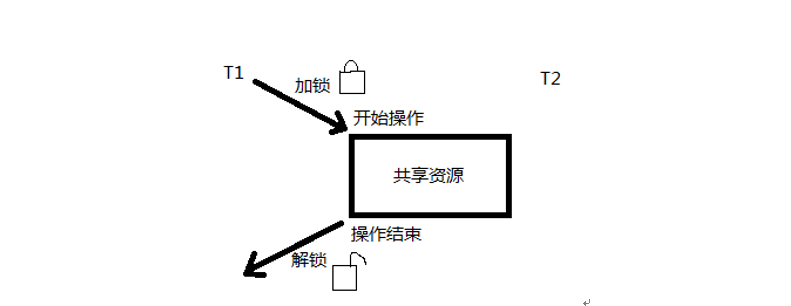前言:学进程时,学习的重点应该进程间通信,而学习线程时,重点就应该是线程同步了。想过为什么?fork创建子进程之后,子进程有自己的独立地址空间和PCB,想和父进程或其它进程通信,就需要各种通信方式,例如无名管道(管道,我习惯这么叫无名管道)、有名管道(命名管道)、信号、消息队列、信号量、共享内存等;而pthread_create创建子线程之后,子线程没有独立的地址空间,大部分数据都是共享的,如果同时访问数据,就是造成混乱,所以要控制,就是线程同步了。
一、同步概念
为什么要特意说一下同步概念呢?因为它跟其他领域的“同步”有些差异。
所谓同步,即同时起步,协调一致。不同的对象,对“同步”的理解方式略有不同。如,设备同步,是指在两个设备之间规定一个共同的时间参考;数据库同步,是指让两个或多个数据库内容保持一致,或者按需要部分保持一致;文件同步,是指让两个或多个文件夹里的文件保持一致。等等
而,编程中、通信中所说的同步与生活中大家印象中的同步概念略有差异。“同”字应是指协同、协助、互相配合。主旨在协同步调,按预定的先后次序运行。
二、线程同步方式
这篇博客主要介绍四种方式,如下:
| 方式 | 通用标识 |
| 互斥锁(互斥量) | pthread_mutex_ |
| 读写锁 | pthread_rwlock_ |
| 条件变量 | pthread_cond_ |
| 信号量 | sem_ |
表中的“通用标识”,指的是那种同步方式的函数、类型都那么开头的,方便记忆;还有其他方式,自旋锁、屏蔽,感觉不常用,有兴趣可以阅读APUE。
三、互斥锁(互斥量)
1、介绍
先来画个图,来简单说明一下: PS:依旧是全博客园最丑图,不接受反驳!

Linux中提供一把互斥锁mutex(也称之为互斥量)。
每个线程在对资源操作前都尝试先加锁,成功加锁才能操作,操作结束解锁。
资源还是共享的,线程间也还是竞争的,
但通过“锁”就将资源的访问变成互斥操作,而后与时间有关的错误也不会再产生了。
2、主要函数
pthread_mutex_init函数 //初始化mutex,默认为1
pthread_mutex_destroy函数 //销毁锁
pthread_mutex_lock函数 //加锁,加锁不成功,一直阻塞在那等待
pthread_mutex_trylock函数 //尝试加锁,加锁不成功,直接返回
pthread_mutex_unlock函数 //解锁
以上5个函数的返回值都是:成功返回0, 失败返回错误号。
pthread_mutex_t 类型,其本质是一个结构体。为简化理解,应用时可忽略其实现细节,简单当成整数看待。
变量mutex只有两种取值1、0。
- pthread_mutex_init函数
初始化一个互斥锁(互斥量) ---> 初值可看作1
原型:int pthread_mutex_init(pthread_mutex_t *restrict mutex, const pthread_mutexattr_t *restrict attr);
参1:传出参数,调用时应传 &mutex
这个restrict关键字可能第一次遇到,说明一下:只用于限制指针,告诉编译器,所有修改该指针指向内存中内容的操作,只能通过本指针完成。不能通过除本指针以外的其他变量或指针修改
参2:互斥量属性。是一个传入参数,通常传NULL,选用默认属性(线程间共享)。互斥锁也可以用于进程间同步,需要修改属性为进程间共享。 参APUE.12.4同步属性
- 静态初始化:如果互斥锁 mutex 是静态分配的(定义在全局,或加了static关键字修饰),可以直接使用宏进行初始化。e.g. pthead_mutex_t muetx = PTHREAD_MUTEX_INITIALIZER;
- 动态初始化:局部变量应采用动态初始化。e.g. pthread_mutex_init(&mutex, NULL)
其他函数就不解释了,相对比较简单。
示例程序,主要对标准输出进行加锁,使主线程打印大写“HELLO WORLD”,子线程打印小写“hello world”,程序如下:

#include <stdio.h> #include <string.h> #include <pthread.h> #include <stdlib.h> #include <unistd.h> pthread_mutex_t mutex; void err_thread(int ret, char *str) { if (ret != 0) { fprintf(stderr, "%s:%s ", str, strerror(ret)); pthread_exit(NULL); } } void *tfn(void *arg) { srand(time(NULL)); while (1) { pthread_mutex_lock(&mutex); printf("hello "); sleep(rand() % 3); /*模拟长时间操作共享资源,导致cpu易主,产生与时间有关的错误*/ printf("world "); pthread_mutex_unlock(&mutex); sleep(rand() % 3); } return NULL; } int main(void) { int flag = 5; pthread_t tid; srand(time(NULL)); pthread_mutex_init(&mutex, NULL); pthread_create(&tid, NULL, tfn, NULL); while (flag--) { pthread_mutex_lock(&mutex); printf("HELLO "); sleep(rand() % 3); printf("WORLD "); pthread_mutex_unlock(&mutex); sleep(rand() % 3); } pthread_cancel(tid); // 将子线程杀死,子线程中自带取消点 pthread_join(tid, NULL); pthread_mutex_destroy(&mutex); return 0; //main中的return可以将整个进程退出 }
编译时也要记得链上-pthread。
四、读写锁
1、特性
(1)读写锁是“写模式加锁”时, 解锁前,所有对该锁加锁的线程都会被阻塞。
(2)读写锁是“读模式加锁”时, 如果线程以读模式对其加锁会成功;如果线程以写模式加锁会阻塞。
(3)读写锁是“读模式加锁”时, 既有试图以写模式加锁的线程,也有试图以读模式加锁的线程。那么读写锁会阻塞随后的读模式锁请求。优先满足写模式锁。读锁、写锁并行阻塞,写锁优先级高
读写锁也叫共享-独占锁。当读写锁以读模式锁住时,它是以共享模式锁住的;当它以写模式锁住时,它是以独占模式锁住的。写独占、读共享。
读写锁非常适合于对数据结构读的次数远大于写的情况。
敲重点了,记住12个字:写独占、读共享;写锁优先级高。
2、主要函数
pthread_rwlock_init函数 //初始化
pthread_rwlock_destroy函数 //销毁锁
pthread_rwlock_rdlock函数 //读加锁,阻塞
pthread_rwlock_wrlock函数 //写解锁,阻塞
pthread_rwlock_tryrdlock函数 //尝试读解锁
pthread_rwlock_trywrlock函数 //尝试写加锁
pthread_rwlock_unlock函数 //解锁
以上7 个函数的返回值都是:成功返回0, 失败直接返回错误号。
pthread_rwlock_t类型 用于定义一个读写锁变量。
pthread_rwlock_t rwlock;
这些参考互斥锁的函数,进行对比学习,只是多了读锁和写锁,就不过多解释了。
实例程序,3个线程“写”全局变量,5个全局变量“读”全局变量,程序如下:

/* 3个线程不定时 "写" 全局资源,5个线程不定时 "读" 同一全局资源 */ #include <stdio.h> #include <unistd.h> #include <pthread.h> int counter; //全局资源 pthread_rwlock_t rwlock; void *th_write(void *arg) { int t; int i = (int)arg; while (1) { t = counter; usleep(1000); pthread_rwlock_wrlock(&rwlock); printf("=======write %d: %lu: counter=%d ++counter=%d ", i, pthread_self(), t, ++counter); pthread_rwlock_unlock(&rwlock); usleep(5000); } return NULL; } void *th_read(void *arg) { int i = (int)arg; while (1) { pthread_rwlock_rdlock(&rwlock); printf("----------------------------read %d: %lu: %d ", i, pthread_self(), counter); pthread_rwlock_unlock(&rwlock); usleep(900); } return NULL; } int main(void) { int i; pthread_t tid[8]; pthread_rwlock_init(&rwlock, NULL); for (i = 0; i < 3; i++) pthread_create(&tid[i], NULL, th_write, (void *)i); for (i = 0; i < 5; i++) pthread_create(&tid[i+3], NULL, th_read, (void *)i); for (i = 0; i < 8; i++) pthread_join(tid[i], NULL); pthread_rwlock_destroy(&rwlock); //释放读写琐 return 0; }
另两种方式,还有条件变量和信号量,条件变量比较难理解,篇幅比较多,所以会另写一篇博客来写,敬请期待哦!
